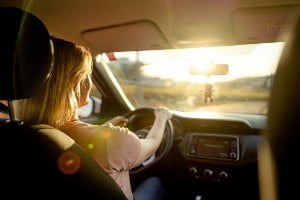Blinded By the Light: What You Should Know About Minneapolis Car Crashes Caused by Sun Glare
 There are many threats to your safety out on the road. One threat many people don’t think about is the sun, specifically sun glare. In fact, sun glare causes thousands of crashes each year, according to the National Highway Traffic Safety Administration.
There are many threats to your safety out on the road. One threat many people don’t think about is the sun, specifically sun glare. In fact, sun glare causes thousands of crashes each year, according to the National Highway Traffic Safety Administration.
You have probably had the experience of struggling to see traffic lights or the cars in front of you because of the position of the sun. Whether you squint, lower the visors, or put on sunglasses, sun glare still has the potential to cause a dangerous crash.
Below, our Minneapolis-based car accident attorneys discuss some of the things you should know about car crashes due to sun glare, including liability for these collisions. If you were injured in a crash and the driver blames sun glare, contact TSR Injury Law to discuss your legal options.
We are here to help. Call today to learn more: (612) TSR-TIME.
When You Are Likely to Encounter Sun Glare
Although the sun is up for about 12 hours each day, sun glare usually affects drivers early in the morning or late in the afternoon. It is easier for the sun to hit horizontal surfaces at these times, causing a bright glare off the road, water, or other vehicles.
The likelihood of sun glare is even higher if you have a dirty windshield as it can reflect off dried dirt, oils or other built-up residue. While you may think sun glare is only a risk in the warmer months, you also need to be careful during the winter months as the sun in lower in the sky and can often cause a bright reflection off the snow.
Liability For Crashes Where Sun Glare May Have Been a Factor
Sun glare can make it harder to see what is happening in front of you. In some cases, drivers literally cannot see for a few seconds, drastically increasing the risk of a dangerous rear-end crash.
Despite the difficulty of driving when dealing with sun glare, drivers cannot blame the sun for a collision. Drivers are expected to account for bad weather, such as sun glare, rain, snow or wind. If drivers do not account for bad weather and exercise additional caution, a crash could occur, and they are likely to be found liable.
Some drivers may say they could not prepare for such bright sunlight. However, it is often sunny outside just before drivers get behind the wheel. Even if it was not sunny at the time of departure, drivers are expected to account for changing weather conditions.
Another thing to remember is that sun glare usually occurs at the same times each day. Many people drive to the same places on a regular basis, meaning they are likely familiar with encountering sun glare. At-fault drivers who claim they did not expect sun glare are probably trying to avoid liability.
Avoiding a Crash When the Sun Affects Your Visibility
There are practical steps drivers can take to reduce the risk of sun glare crashes, such as:
Wearing Sunglasses
Polarized sunglasses can make it much easier to see when the sun is directly in front of you. However, if you have ever dealt with sun glare, you know sometimes sunglasses are not strong enough. You can also lower the visor inside your car to keep more of the sunlight out.
Cleaning Your Windshield
Every so often you should give your windshield a thorough cleaning to remove dirt. While driving, windshield wipers do a good job of cleaning the driver’s direct line of sight, however, often leaves residue on the outside of the wiper blade path. In addition to cleaning off left over residue, it is also recommended to replace old wiper blades and ensure your vehicle has enough wiper fluid.
Leaving Extra Space Between Your Car and the One in Front of You
When visibility is an issue, you should always leave more space between your car and the one in front of you. This gives you extra time to stop in case you lose track of how close you are to the back of that vehicle. A good rule of thumb is to keep three seconds of space in-between you and the vehicle in front of you.
Try a Different Route
This is not always possible, but if sun glare is a regular problem, you might consider taking a different route to or from work. While you might add a few minutes to your drive, not having the sun in your eyes may make your commute safer.
Another option is to leave earlier, avoiding the glare before it becomes an issue.
Turn on Your Headlights
Driving with your headlights on makes it easier for oncoming vehicles to see you. This should give other drivers more time to correct mistakes and adjust if they encounter sun glare.
What To Do After a Crash Caused By Sun Glare
You should handle the aftermath of a sun glare crash the same way you would handle the aftermath of any other collision:
- Call 9-1-1
- Tell the police what happened
- Go to the hospital right away
- Do not sign anything the insurance company asks you to sign
- Contact an experienced lawyer to review your legal options
The other driver may try to blame the crash on sun glare. However, this is not a legitimate excuse.
That said, there is no reason to get into an argument with the other driver. Exchange information and wait for the police to arrive.
Contact Us To Discuss Your Car Crash Claim
Do you have questions after a Minneapolis car crash?
TSR Injury Law has been helping crash victims for decades. During that time, our firm has obtained more than $1 billion on behalf of our clients.
The initial consultation with an experienced attorney at our firm is free of charge, and there are no fees while we work on your case.
We do not get paid unless you get paid. Call for legal help: (612) TSR-TIME.



